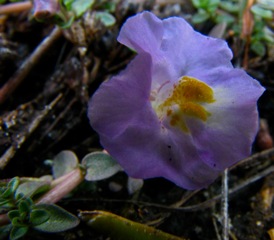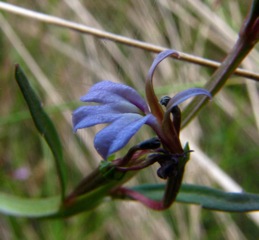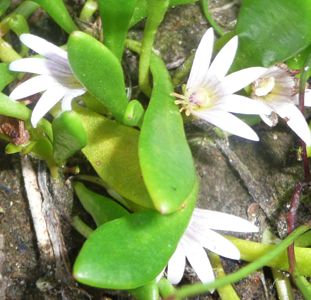This month, we will concentrate on plants growing in swampy areas near watercourses and inlets, as there are some real delights to be found, and most are flowering later than normal.

Creeping Monkey-flower
Creeping Monkey-flower Mimulus repens, a favourite of mine, is flowering abundantly along the edge of the Anglesea River. It is a prostrate plant, with crowded pairs of succulent, oval, stalkless leaves. The delicate, mauve flowers open out, looking like small butterfly wings. In the centre, they have an entrancing pair of raised, oval, yellow, downy areas, with a white edge blending into the mauve.

Angled Lobelia
Angled Lobelia Lobelia anceps is another very pretty flower to look out for; its five-petalled, blue flowers have an unusual spacing that is quite uneven. A couple of plants with uneven white flowers are also in bloom.

Shiny Swamp-mat
Shiny Swamp-mat Selliera radicans has quite large, fan-shaped flowers, and long, fleshy, spoon-shaped leaves.

Salt Pratia
With a really careful look, you may spy the tiny, white, uneven flowers of Salt Pratia Lobelia irrigua, which are dwarfed by the succulent, matted, oval leaves.

Creeping Brookweed
Creeping Brookweed Samolus repens var. repens, a widespread small-leaved creeping plant, had massed flowering in the summer, and still has many small, white to pink, five-petalled flowers.
The low growing plant, Glaucus Goosefoot Chenopodium glaucum, is starting to display its autumn colours, as the normally green, arrowhead shaped leaves change to pink, and sometimes bright red. The small knobby flowers, which grow along the ends of the stems, may also look quite pink.
Massed flowering of Slender Knotweed Persicaria decipiens has turned the Allen Noble Sanctuary into a sea of pink. This low growing, spreading plant has green leaves to 15 cm, often with a dark blotch. The small flowers grow in long, slender, often paired spikes, at the ends of the stalks.
Finally, the ‘smelly’ plant of the month, Coast Daisy-bush Olearia axillaris, is a coastal bush that is a highlight of dune areas, because of its lovely greyish foliage. It is developing greyish buds in the leaf axils, which will become small, stalkless, creamy/yellow flowers. A wonderful, aromatic smell is released when the leaves are crushed.
Enjoy your autumn walks, and don’t forget to take Flowers of Anglesea and Aireys Inlet.
Ellinor Campbell